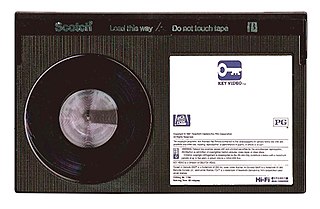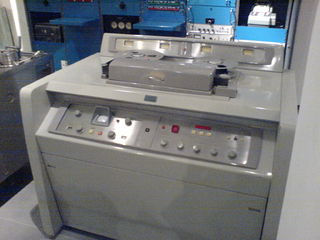Related Research Articles

Magnetic tape is a medium for magnetic recording, made of a thin, magnetizable coating on a long, narrow strip of plastic film. It was developed in Germany in 1928, based on magnetic wire recording. Devices that record and playback audio and video using magnetic tape are tape recorders and video tape recorders respectively. A device that stores computer data on magnetic tape is known as a tape drive.

Video is an electronic medium for the recording, copying, playback, broadcasting, and display of moving visual media. Video was first developed for mechanical television systems, which were quickly replaced by cathode ray tube (CRT) systems which were later replaced by flat panel displays of several types.

VHS is a standard for consumer-level analog video recording on tape cassettes.

Digital Audio Tape is a signal recording and playback medium developed by Sony and introduced in 1987. In appearance it is similar to a Compact Cassette, using 3.81 mm / 0.15" magnetic tape enclosed in a protective shell, but is roughly half the size at 73 mm × 54 mm × 10.5 mm. The recording is digital rather than analog. DAT can record at sampling rates equal to, as well as higher and lower than a CD at 16 bits quantization. If a comparable digital source is copied without returning to the analogue domain, then the DAT will produce an exact clone, unlike other digital media such as Digital Compact Cassette or non-Hi-MD MiniDisc, both of which use a lossy data reduction system.
Wiping, also known as junking, is a colloquial term of art for action taken by radio and television production and broadcasting companies, in which old audiotapes, videotapes, and telerecordings (kinescopes), are erased, reused, or destroyed. Although the practice was once very common, especially in the 1960s and 1970s, wiping is now practiced much less frequently.

Videotape is magnetic tape used for storing video and usually sound in addition. Information stored can be in the form of either an analog signal or digital signal. Videotape is used in both video tape recorders (VTRs) or, more commonly, videocassette recorders (VCRs) and camcorders. Videotapes are also used for storing scientific or medical data, such as the data produced by an electrocardiogram.

Kinescope, shortened to kine, also known as telerecording in Britain, is a recording of a television program on motion picture film, directly through a lens focused on the screen of a video monitor. The process was pioneered during the 1940s for the preservation, re-broadcasting and sale of television programmes before the introduction of videotape, which from 1956 eventually superseded the use of kinescopes for all of these purposes. Kinescopes were the only practical way to preserve live television broadcasts prior to videotape.

Betamax is a consumer-level analog-recording and cassette format of magnetic tape for video, commonly known as a video cassette recorder. It was developed by Sony and was released in Japan on May 10, 1975, followed by the US in November of the same year.

Ampex is an American electronics company founded in 1944 by Alexander M. Poniatoff as a spin-off of Dalmo-Victor. The name AMPEX is a portmanteau, created by its founder, which stands for Alexander M. Poniatoff Excellence. Today, Ampex operates as Ampex Data Systems Corporation, a subsidiary of Delta Information Systems, and consists of two business units. The Silicon Valley unit, known internally as Ampex Data Systems (ADS), manufactures digital data storage systems capable of functioning in harsh environments. The Colorado Springs, Colorado unit, referred to as Ampex Intelligent Systems (AIS), serves as a laboratory and hub for the company's line of industrial control systems, cyber security products and services and its artificial intelligence/machine learning technology.

A video tape recorder (VTR) is a tape recorder designed to record and play back video and audio material from magnetic tape. The early VTRs were open-reel devices that record on individual reels of 2-inch-wide tape. They were used in television studios, serving as a replacement for motion picture film stock and making recording for television applications cheaper and quicker. Beginning in 1963, videotape machines made instant replay during televised sporting events possible. Improved formats, in which the tape was contained inside a videocassette, were introduced around 1969; the machines which play them are called videocassette recorders.

The 8mm video format refers informally to three related videocassette formats for the NTSC and PAL/SECAM television systems. These are the original Video8 format and its improved successor Hi8, as well as a more recent digital recording format known as Digital8.
High-definition video is video of higher resolution and quality than standard-definition. While there is no standardized meaning for high-definition, generally any video image with considerably more than 480 vertical scan lines or 576 vertical lines (Europe) is considered high-definition. 480 scan lines is generally the minimum even though the majority of systems greatly exceed that. Images of standard resolution captured at rates faster than normal, by a high-speed camera may be considered high-definition in some contexts. Some television series shot on high-definition video are made to look as if they have been shot on film, a technique which is often known as filmizing.

2-inch quadruplex videotape was the first practical and commercially successful analog recording video tape format. It was developed and released for the broadcast television industry in 1956 by Ampex, an American company based in Redwood City, California. The first videotape recorder using this format was built in the same year. This format revolutionized broadcast television operations and television production, since the only recording medium available to the TV industry before then was film used for kinescopes, which was much more costly to utilize, could only be used once, images could be ruined by light leaks if the film was not developed and took time to develop at a film laboratory. In addition, kinescope images were usually of obviously inferior quality to the live television broadcast images they recorded, whereas quadruplex videotape preserved almost all the image detail of a live broadcast.

Peter Carl Goldmark was a Hungarian-American engineer who, during his time with Columbia Records, was instrumental in developing the long-playing microgroove 331⁄3 rpm phonograph disc, the standard for incorporating multiple or lengthy recorded works on a single disc for two generations. The LP was introduced by Columbia's Goddard Lieberson in 1948. Lieberson was later president of Columbia Records from 1956–71 and 1973–75. According to György Marx he was one of The Martians.

The history of sound recording - which has progressed in waves, driven by the invention and commercial introduction of new technologies — can be roughly divided into four main periods:
CBS Laboratories or CBS Labs was the technology research and development organization of the CBS television network. Innovations developed at the labs included many groundbreaking broadcast, industrial, military, and consumer technologies.

Multitrack recording of sound is the process in which sound and other electro-acoustic signals are captured on a recording medium such as magnetic tape, which is divided into two or more audio tracks that run parallel with each other. Because they are carried on the same medium, the tracks stay in perfect synchronisation, while allowing multiple sound sources to be recorded at different times.
High-definition television (HD) describes a television system providing an image resolution of substantially higher resolution than the previous generation of technologies. The term has been used since 1936, but in modern times refers to the generation following standard-definition television (SDTV), often abbreviated to HDTV or HD-TV. It is the current de facto standard video format used in most broadcasts: terrestrial broadcast television, cable television, satellite television, and Blu-ray Discs.

A videocassette recorder (VCR) or video recorder is an electromechanical device that records analog audio and analog video from broadcast television or other source on a removable, magnetic tape videocassette, and can play back the recording. Use of a VCR to record a television program to play back at a more convenient time is commonly referred to as timeshifting. VCRs can also play back prerecorded tapes. In the 1980s and 1990s, prerecorded videotapes were widely available for purchase and rental, and blank tapes were sold to make recordings.
The following timeline tables list the discoveries and inventions in the history of electrical and electronic engineering.
References
- ↑ "New Playback Device for TV Viewers", Chicago Tribune, August 28, 1967, p2-18
- ↑ NYU, History of Electronic Video Recording (EVR), Hammer
- ↑ BEKERS' CURIOUS EVR DONATIONS
- ↑ CED in the History of Media Technology, 1969: CBS EVR or Electronic Video Recording System Prototype
- ↑ "Iwata Asks: Punch-Out!! - The Proposition is to Use Two Televisions". Nintendo. 2009-08-07. Archived from the original on January 11, 2010. Retrieved 2009-08-07.
- ↑ Kohler, Chris (July 5, 2017). "Nintendo Has Now Been Making Video Games For 40 Years". Kotaku . Retrieved 19 May 2021.
- ↑ "調査対象5年間のベスト1" [Best 1 of the 5 years surveyed](PDF). Game Machine (in Japanese). No. 159. Amusement Press, Inc. 15 February 1981. p. 1.